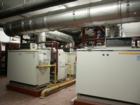The flue as a key part of boiler efficiency

Although a separate chimney for each boiler has inherent functional advantages, most boiler installations have a common header and chimney system for all the boilers.
Peter Roege considers how UN and British climate-change policies impact on the design and operation of boiler houses. affect your boiler house.It is pretty clear from the grim forecasts that emerged from the recent climate change summit in Valencia and from the commissioning by Ban Ki-Moon of a major UN report on climate change measures that pressures on industry, both legislative and moral, will mount. Organisations will be required to reduce their carbon footprint, cut emissions and become more energy efficient. Since the boiler house is, on many sites, the biggest single user of energy, much of the focus will be on boiler efficiency. The snag is that just buying new and more efficient boilers is unlikely to meet whatever new targets are set — unless the whole boiler house structure and system is designed to achieve maximum efficiency, and appropriate monitoring systems are in place to ensure that the efficiency is maintained. The design of the boiler system must enable the selected boilers to operate at their maximum efficiency, which varies with loading.
Specifying for maximum efficiency Consultations with the boiler manufacturer and a detailed study of the range of demand for heat over a period should make it possible to specify the boiler installation and its controls for maximum efficiency. The objective must always be to keep whichever boilers are being called on for heat running at the load at which they deliver the greatest output for the least energy. Where an installation has a major differential in heat demand during each 24-hour period, or during the week, greatest efficiency is usually achieved by having a number of boilers of smaller output operating in cascade, rather than one or two larger boilers whose output is appropriate to peak demand. It is also vital to allow for downtime caused by routine maintenance. A multi-boiler system can usually be configured to deliver adequate output for low-demand periods, even when one or more boilers are out of commission for servicing. And then there’s the flue. Although you have the right number of boilers, correctly configured and controlled, you may still not have solved the efficiency problem. The flue and chimney system must also be designed correctly and, like the boilers, be properly controlled to achieve efficiency. It must be designed and installed not simply to exhaust the waste gas to atmosphere, but also to provide a stable operating pressure at the boiler flue outlet under various levels of boiler loading. The importance of flue and chimney design is often not fully appreciated and the design can become compromised by the nature of an existing boiler house structure or by a need for compromise in the siting the flue termination. A separate chimney for each boiler has inherent functional advantages, because the operation of the chimney can be managed by the combustion-air controls on the boiler. However, four tall chimneys for a 4-boiler installation are unsightly and expensive. Most boiler installations therefore have a common header and chimney system for all the boilers, an arrangement originally used for atmospheric gas boilers with draught breaks. However, with modern systems with other fuels, or multi-fuel installations, with no draught breaks, it is important that the design of the common flue and chimney system achieves a stable operating pressure at each boiler flue connection. The problem is that the operating pressure varies according to the number of boilers operating at any given time, and this variation cannot be compensated for by the boilers’ combustion-air controls.
Controlling the draught The answer is to control the chimney draught. Some degree of control can be achieved by carefully siting draught stabilisers in the flue system, and additional control can be achieved with a variable-speed fan on the flue system, located after the boiler flue pipe connections and controlled by a pressure sensor in the header above the boiler connections — but there is a much better way. The best approach is the use of a fully controlled constant-pressure chimney automation system with the ability to control, monitor and maintain pre-set draught standards. Controlling the draught in the flue can dramatically increase the energy efficiency of boiler installations of all types and fuels. Tests in the USA of the Exhausto CAS system, for example, have shown savings of up to 30%, which is the sort of level likely to be required by climate-change legislation arising from the UN report and other international pressures. There are also safety advantages. Because the CAS system monitors the chimney draught constantly, it can be configured to shut down the boiler system should the draught fall more than 40% below the set point for more than 12 seconds, thus avoiding a seriously hazardous situation and eliminating the risk of carbon monoxide spillage. Indeed, the Exhausto CAS includes a carbon-monoxide spillage-warning device as a standard feature. Chimney automation has the added advantage of eliminating many problems with burners that can cause downtime, such as pilot-light failure or instability, loss of flame retention and consequent ‘flame-failure’ shutdowns and flame pulsations that can cause noise problems. Be assured that new requirements for energy saving and reduced emissions are coming — and chimney automation systems should be part of the response. Peter Roege is with Exhausto.
Related links:









